

Up: Electron-impact excitation rates of
Effective collision strengths obtained for all the transitions
among 3s, 3p, 3d, 4s, 4p, 4d and 4f states are given
in Tables 3-7 for Al III, Si IV,
S VI, Ar VIII
and Ca X, respectively. The temperature range
considered is around the temperature (T ) of
maximum fractional abundance
in ionization equilibrium of the respective species. According to the
calculation by Arnaud & Rothenflug (1985), Log T
) of
maximum fractional abundance
in ionization equilibrium of the respective species. According to the
calculation by Arnaud & Rothenflug (1985), Log T for Al III, Si IV, S VI,
Ar VIII and Ca X are, respectively,
4.6, 4.8, 5.3, 5.6 and 5.8.
for Al III, Si IV, S VI,
Ar VIII and Ca X are, respectively,
4.6, 4.8, 5.3, 5.6 and 5.8.
For Al III, Si IV and S VI,
Dufton & Kingston (1987) reported their
rate coefficients for the transitions among 3s, 3p, 3d, 4s and 4p. They
took account of only 5-states (3s, 3p, 3d, 4s and 4p) in their calculation.
In principle, the present 11-state calculation should be much better than
theirs, especially for the n = 3-4 transition. Figure 1
shows a typical example
(the 3s-4p)
of the comparison between their result and the present one.
There is a
discrepancy of up to a factor of two.
Mitroy & Norcross (1989) also
obtained the rate coefficient for Al III.
They used five atomic states and four pseudostates ( ,
,
 ,
,  and
and  )in the close-coupling approximation.
Their results are much smaller than those of present calculation
for the 3s-4p transition, whereas for the n = 3-3 transitions the
agreement
between the two calculations is good within 10%.
It is seen that the effect of including n=5 states in the present calculation
is important.
Keenan et al. (1996) determined the rate coefficients for Na-like
ions, based on the interpolation of results in the
R-matrix calculations available for
some particular Na-like species. When compared with the present
calculation, their data in some cases show a large disagreement.
Figure 2
shows one example. The procedure taken by Keenan et al. (1996)
implicitly assumes
a scaling of the effective collision strengths along the isoelectronic
sequence.
)in the close-coupling approximation.
Their results are much smaller than those of present calculation
for the 3s-4p transition, whereas for the n = 3-3 transitions the
agreement
between the two calculations is good within 10%.
It is seen that the effect of including n=5 states in the present calculation
is important.
Keenan et al. (1996) determined the rate coefficients for Na-like
ions, based on the interpolation of results in the
R-matrix calculations available for
some particular Na-like species. When compared with the present
calculation, their data in some cases show a large disagreement.
Figure 2
shows one example. The procedure taken by Keenan et al. (1996)
implicitly assumes
a scaling of the effective collision strengths along the isoelectronic
sequence.
![\begin{figure}
\includegraphics [width=8.5cm]{h0858f2.eps}\end{figure}](/articles/aas/full/1998/16/h0858/Timg31.gif) |
Figure 2:
Effective collision strengths of the 3s-4s excitation
for Ar VIII and Ca X
as a function of temperature (in K).
Ar VIII: --- present, -  - Keenan et al. (1996),
Ca X: - - - present,
- - Keenan et al. (1996),
Ca X: - - - present,
-   - Keenan et al. (1996) - Keenan et al. (1996) |
![\begin{figure}
\includegraphics [width=8.5cm]{h0858f3.eps}\end{figure}](/articles/aas/full/1998/16/h0858/Timg32.gif) |
Figure 3:
Cross section for the 3s-3p excitation of Si IV
as a function of
electron energy (in Ryd). The excitation energy of this
transition is 0.6524 Ryd. --- present,  the experiment of Wåhlin et al. (1991) the experiment of Wåhlin et al. (1991) |
Table 3:
Effective collision strengths for Al III
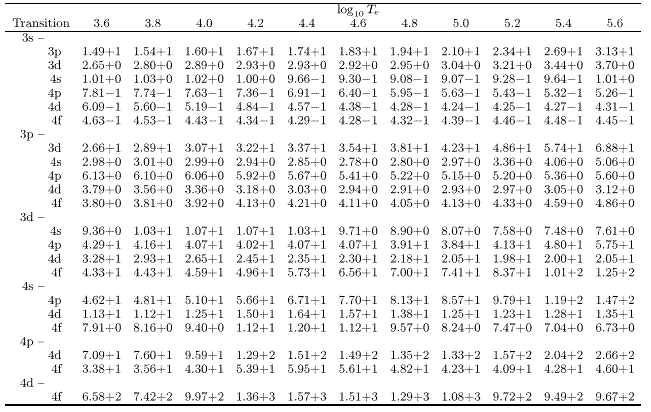
|
Table 4:
Effective collision strengths for Si IV
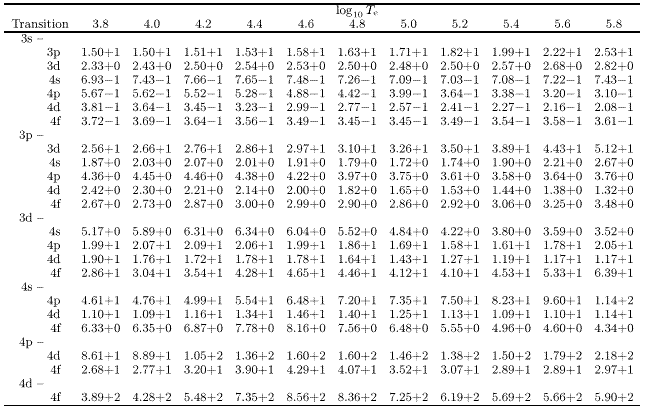
|
Table 5:
Effective collision strengths for S VI
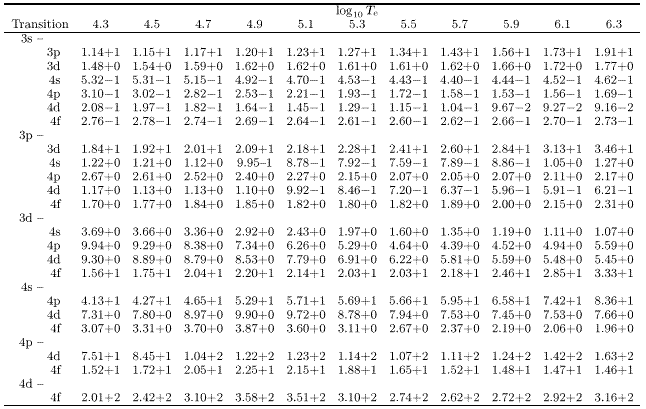
|
Table 6:
Effective collision strengths for Ar VIII
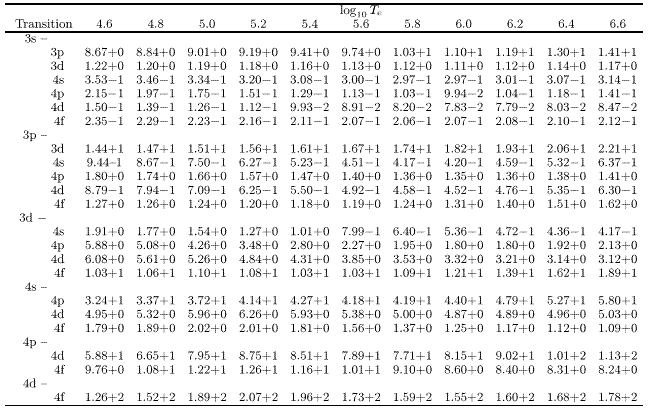
|
Table 7:
Effective collision strengths for Ca X
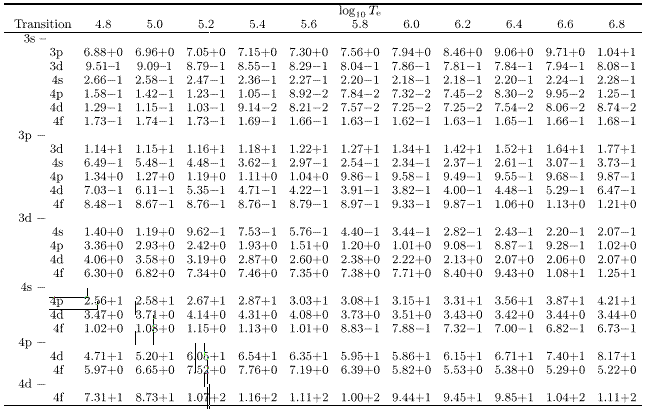
|
There is no experimental determination of the rate coefficients for
the Na-like ions considered here. Experimental data are available,
however, for the excitation cross sections of
Si IV (Wåhlin et al. 1991)
and Ar VIII (Guo et al. 1993). In Fig. 3, we compare the present cross
section for the 3s-3p excitation of Si IV with
the corresponding
experimental values. No adjustment has been done of the absolute
magnitude in both the cross
section data. In this sense, the agreement is
quite good. For
Ar VIII, a similar agreement is
obtained between the
present calculation and the experiment (see Paper I,
where a comparison of the cross section for Ar VIII with several
other calculations has also been made). Since no experimental data are
available to test the resonance structure in the cross sections for the
present ions, it is difficult to critically assess the accuracy of the
present rate coefficients. From other R-matrix calculations for other
ions, however, the values given in Tables 3-7 should be reliable for
practical applications.
Acknowledgements
The R-matrix code used here has been kindly provided to the present
authors by Dr. K.A. Berrington under the UK-Japan collaboration program
on the theory of atomic collision. The present work was supported by
a Grant-in-Aid for Scientific Research on Priority Area "Atomic Physics of
Multicharged Ions'' from the Ministry of Education, Science and
Culture of Japan.


Up: Electron-impact excitation rates of
Copyright The European Southern Observatory (ESO)
![\begin{figure}
\includegraphics [width=8.5cm]{h0858f1.eps}\end{figure}](/articles/aas/full/1998/16/h0858/Timg29.gif)
![\begin{figure}
\includegraphics [width=8.5cm]{h0858f2.eps}\end{figure}](/articles/aas/full/1998/16/h0858/Timg31.gif)
![\begin{figure}
\includegraphics [width=8.5cm]{h0858f3.eps}\end{figure}](/articles/aas/full/1998/16/h0858/Timg32.gif)




